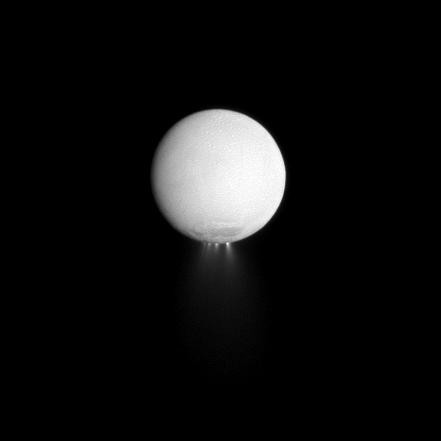Water On Saturn Rained From Its Moon, ESA's Herschel Confirms

A 14-year mystery was solved when an icy moon around Saturn was identified as the source of the water vapor in the planet's upper atmosphere.
Enceladus, Saturn's six-largest moon, expels over 550 pounds of water vapor every second toward Saturn via a collection of jets from the south polar region, according to The European Space Agency (ESA). ESA discovered the water surrounding Saturn raining from Enceladus, a breakthrough observation by its Herschel Space Observatory, a space telescope with the largest single mirror ever built.
The findings mean that Enceladus is the only moon in the Solar System known to influence the chemical composition of its parent planet.
The icy moon, discovered in 1789, orbits the planet at a distance of about four Saturn radii, replenishing the torus with its jets of water, according to ESA's report.
The water raining onto Saturn creates a doughnut-shaped torus of water vapor. The torus measures more than 10 times the radius of Saturn, but is one Saturn-radius thick.
First reported in 1997 by teams using ESA's Infrared Space Observatory, the source of Saturn's water was unknown until now. Scientists were unable to make the connection between the previous observations of the water vapor in Saturn's atmosphere and the jets of Enceladus.
The massive torus has escaped detection until now because water vapor is transparent to visible light, says ESA's report. Herschel could spot the feature because it was designed to see at the infrared wavelengths.
"These are observations that only Herschel can make," said Göran Pilbratt, ESA Herschel project scientist. "ESA's Infrared Space Observatory found the water vapor in Saturn's atmosphere. Then NASA/ESA's Cassini/Huygens mission found the jets of Enceladus. Now Herschel has shown how to fit all these observations together."
Analysis leader Paul Hartogh, Max-Planck-Institut für Sonnensystemforschung, Katlenburg-Lindau in Germany said, "There is no analogy to this behaviour on Earth. No significant quantities of water enter our atmosphere from space. This is unique to Saturn."
Majority of the water discharged from Enceladus is either lost in space, freezes on Saturian rings or even falls onto one of Saturn's other 62 known moons. Only a small fraction of the water, however, strikes Saturn to form the torum of water vapor found in the upper atmosphere of the planet. The water is then distributed to the lower level atmosphere of Saturn to condense.
The vapor is also responsible for the production of additional oxygen-bearing compounds, such as carbon dioxide, scientists said.
"Herschel has proved its worth again. These are observations that only Herschel can make," says Göran Pilbratt, ESA Herschel Project Scientist.
© Copyright IBTimes 2025. All rights reserved.





















